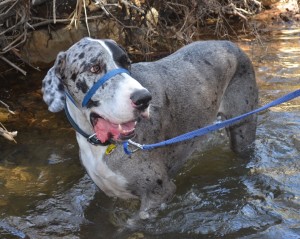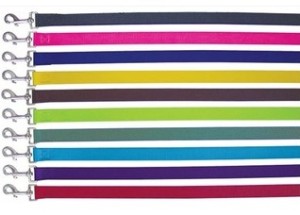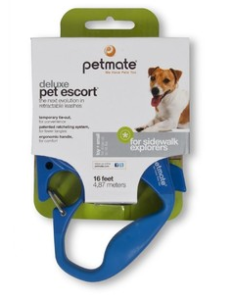I have been walking dogs professionally for 5 years, and during that time I have walked everything from a 3kg cavoodle to a 100kg mastiff, not to mention my own 80kg (and somewhat reactive) great Dane. I’ve also used just about every type of lead, collar, and harness on the market. As you can imagine, I’ve learned through experience what equipment and methods work, and what doesn’t, to make the walk enjoyable for both humans and dogs. Today I am going to discuss my experience with dog leads, and later in the week will share my thoughts on other equipment (collars and harnesses) and then the training and handling methods you can use while walking your dog.
Leads
These days there is a large range of fancy-pants leads for walking dogs. You can get retractable leads, bungy leads, leads with ergonomic handles, two-dog split leads, hands free leads, and adjustable leads. And these can come in nylon, leather, cotton, chain, plastic, or all sorts of pretty designer materials. The range of prices for dog leads is just as vast as it is for styles, with the cost of leashing your dog ranging from under $5 to almost $100. Just take a look at the range at a shop like Mammoth Pet Supplies to see what I mean.
No matter the style, the manufacturers will probably tell you their lead is durable, comfortable, prevents pulling, and is safe. So with so many choices, what should you spend your money on? Well the style of lead I have found to be the most durable, comfortable, pull-preventing, and safe is… (drumroll please)… also the simplest!
These woven synthetic leads are far-and-away the best dog walking tool on the market (and from Mammoth Pet Supplies just $12.95 with cheap postage, and they are pretty easy to find in any pet shop). I prefer 120cm (4′) leads though they also come in 180cm (6′) versions that you might prefer, though they offer a bit less control and are more likely to tangle or drag on the ground than a 120cm version. If you have a toy-sized dog it might be worth getting a thinner lead than the 25mm ones, so that the large clip doesn’t put too much strain on your little dog, but if your dog is big enough to give a reasonable tug on the lead I recommend the 25mm width as it’ll be more comfortable for you to hold.
The soft, flexible handle these leads have is so much more comfortable than “ergonomically designed” handles, and is also much easier to get a very strong grip on so you don’t accidentally let go of your dog. They’re also unlikely to break your wrist should your dog pull hard enough, so long as you keep a sensible grip on the lead (I’ll go through good ways to hold a lead in a later post!) They’re also lightweight so don’t add any excess strain to your arm or to your dog’s neck, like many plastic or chain leads can.

Banana has had the same nylon webbing lead for 3 years, used on countless dog walks and adventures, and it still going strong.
Admittedly woven leads won’t stand up to excessive chewing, but that’s an issue that can be solved more easily with training than equipment. Otherwise they are extremely durable, even after getting wet and salty at the beach or being left in the sun for weeks on end.
And yes, these simple leads are the most effective tool for stopping a dog from pulling, especially in the long term. Stretchy, adjustable, and extendable leads, though often advertised to stop pulling, actually prevent your dog learning where the end of the lead actually is – the boundary between loose lead walking and pulling. Teaching your dog where that boundary is is the first step in training them to walk nicely, and without it your training is doomed to fail.
My absolute least favourite type of lead (thanks for asking!) is the dreaded retractable lead. Firstly, it might actually be against the law to walk your dog with one of these leads! The legislation requires that in areas where a dog must be on lead (that is, almost everywhere in suburbia in WA) the lead can’t be longer than 2m, and most retractable leads are 3m or longer, allowing your dog to get further away from you than the law considers safe. They also almost always have handles that are difficult to get a safe grip on and can easily be yanked from your hand when your dog hits the end of the extendable length of lead.
The third and greatest complaint I have against retractable leads is that you can’t safely pull your dog back in to you if needed, as the cord is too thin to grip. In my early days of dog walking, when I still used client’s leads rather than my own, I was walking a medium sized dog on a retractable lead. A tiny dog ran our way and the owner was clearly concerned, so I quickly tried to grab the lead to bring the dog back to me. I ended up with a very deep cut in my hand as the thin cord continued to extend as the dog was running away from me, slicing into my hand. OUCH! That’s pretty much when I made the decision to always use my own lead to walk dogs!
Retractable leads do have their place, however they shouldn’t be used for walking dogs. What they can be used for is training a dog to recall or do other tasks off lead, in the step before you are ready to remove the lead completely. You can also get long leads that are not retractable for this task, and for large dogs I’d definitely go with these as they are easier to grip, but they also tangle and weigh small dogs down, so retractable leads can be better for small dogs. Just remember; if it’s longer than 2m, it’s a tool to transition to getting off lead in designated off lead areas, not a lead to used in on-lead areas!
At the end of the day, I think the most important thing is that you are comfortable with your choice of leash, so you can enjoy walking with your dog. So if you just love your 2m, plastic-handled, chain, split, adjustable lead, that’s fine. But if you’ve been wondering which of the fancy leads you’ve seen at the pet shop you should spend your money on, take it from me that you should go with those nice, simple, gimmick free, synthetic woven leads.
Next time: What collars, harnesses, or other equipment I like to use.
Megan

